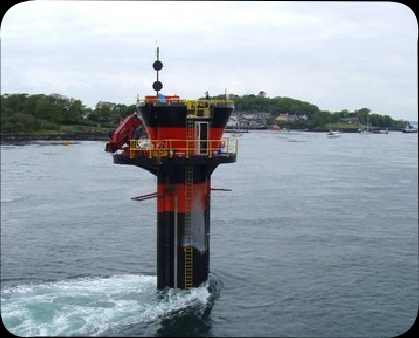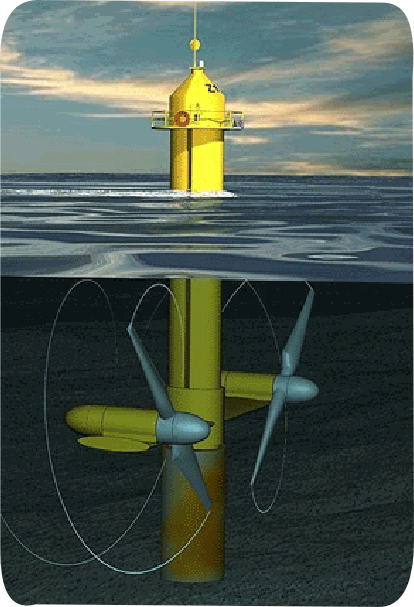



Tidal power, sometimes called tidal energy, is a form of hydropower that converts the energy of tides into electricity or other useful forms of power.
Although not yet widely used, tidal power has potential for future electricity generation. Tides are more predictable than wind energy and solar power. Historically, tide mills have been used, both in Europe and on the Atlantic coast of the USA. The earliest occurrences date from the Middle Ages, or even from Roman times.
Generation of tidal energy
Tidal power is the only form of energy which derives directly from the relative motions of the Earth–Moon system, and to a lesser extent from the Earth–Sun system. The tidal forces produced by the Moon and Sun, in combination with Earth's rotation, are responsible for the generation of the tides. Other sources of energy originate directly or indirectly from the Sun, including fossil fuels, conventional hydroelectric, wind, biofuels, wave power and solar. Nuclear is derived using radioactive material from the Earth, geothermal power uses the heat of magma below the Earth's crust, which comes from radioactive decay.
Tidal energy is generated by the relative motion of the Earth, Sun and the Moon, which interact via gravitational forces. Periodic changes of water levels, and associated tidal currents, are due to the gravitational attraction by the Sun and Moon. The magnitude of the tide at a location is the result of the changing positions of the Moon and Sun relative to the Earth, the effects of Earth rotation, and the local shape of the sea floor and coastlines.
Because the Earth's tides are caused by the tidal forces due to gravitational interaction with the Moon and Sun, and the Earth's rotation, tidal power is practically inexhaustible and classified as a renewable energy source.
A tidal energy generator uses this phenomenon to generate energy. The stronger the tide, either in water level height or tidal current velocities, the greater the potential for tidal energy generation.
Tidal movement causes a continual loss of mechanical energy in the Earth–Moon system due to pumping of water through the natural restrictions around coastlines, and due to viscous dissipation at the seabed and in turbulence. This loss of energy has caused the rotation of the Earth to slow in the 4.5 billion years since formation. During the last 620 million years the period of rotation has increased from 21.9 hours to the 24 hours we see now; in this period the Earth has lost 17% of its rotational energy. While tidal power may take additional energy from the system, increasing the rate of slowdown, the effect would be noticeable over millions of years only, thus being negligible.
Categories of tidal power
Tidal power can be classified into two main types:
· Tidal stream systems make use of the kinetic energy of moving water to power turbines, in a similar way to windmills that use moving air. This method is gaining in popularity because of the lower cost and lower ecological impact compared to barrages.
· Barrages make use of the potential energy in the difference in height (or head) between high and low tides. Barrages are essentially dams across the full width of a tidal estuary, and suffer from very high civil infrastructure costs, a worldwide shortage of viable sites, and environmental issues.
· Tidal lagoons, are similar to barrages, but can be constructed as self contained structures, not fully across an estuary, and are claimed to incur much lower cost and impact overall. Furthermore they can be configured to generate continuously which is not the case with barrages.
Modern advances in turbine technology may eventually see large amounts of power generated from the ocean, especially tidal currents using the tidal stream designs but also from the major thermal current systems such as the Gulf Stream, which is covered by the more general term marine current power. Tidal stream turbines may be arrayed in high-
Tidal stream generators
A relatively new technology, tidal stream generators draw energy from currents in much the same way as wind turbines. The higher density of water, 832 times the density of air, means that a single generator can provide significant power at low tidal flow velocities (compared with wind speed). Given that power varies with the density of medium and the cube of velocity, it is simple to see that water speeds of nearly one-
Since tidal stream generators are an immature technology (no commercial scale production facilities are yet routinely supplying power), no standard technology has yet emerged as the clear winner, but a large variety of designs are being experimented with, some very close to large scale deployment. Several prototypes have shown promise with many companies making bold claims, some of which are yet to be independently verified, but they have not operated commercially for extended periods to establish performances and rates of return on investments.
Horizontal axis turbines
These are close in concept to traditional windmills operating under the sea and have the most prototypes currently operating. These include:
Kvalsund, south of Hammerfest, Norway. Although still a prototype, a turbine with a reported capacity of 300 kW was connected to the grid on 13 November 2003.
A 300 kW Periodflow marine current propeller type turbine — Seaflow — was installed by Marine Current Turbines off the coast of Lynmouth, Devon, England, in 2003. The 11m diameter turbine generator was fitted to a steel pile which was driven into the seabed. As a prototype, it was connected to a dump load, not to the grid.
Since April 2007 Verdant Power has been running a prototype project in the East River between Queens and Roosevelt Island in New York City; it was the first major tidal-
Following the Seaflow trial, a fullsize prototype, called SeaGen, was installed by Marine Current Turbines in Strangford Lough in Northern Ireland in April 2008. The turbine began to generate at full power of just over 1.2 MW in December 2008 and was reported to have fed 150kW into the grid for the first time on 17 July 2008. It is currently the only commercial scale device to have been installed anywhere in the world.
OpenHydro, an Irish company exploiting the Open-
Vertical axis turbines
The Gorlov turbine is a variant of the Darrieus design featuring a helical design which is being commercially piloted on a large scale in S. Korea. Neptune Renewable Energy has developed Proteus which uses a barrage of vertical axis crossflow turbines for use mainly in estuaries.

The world's first commercial tidal stream generator — SeaGen — in Strangford Lough. The strong wake shows the power in the tidal current.
Rance tidal power plant

The SeaGen rotors in Harland & Wolff shipyards, Belfast before installation in Strangford Lough.

Tidal Generator

Much less controversial though less productive per unit width of the installation are stream tidal power installations that use submerged rotors in areas with high-
.gif)
Variations of tides per day
Oscillating devices
These don't use rotary devices at all but rather aerofoil sections which are pushed sideways by the flow.
Oscillating stream power extraction was proven with the omni or bi-
During 2003 a 150kW oscillating hydroplane device, the Stingray, was tested off the Scottish coast.
Venturi effect
This uses a shroud to increase the flow rate through the turbine. These can be mounted horizontally or vertically.
The Australian company Tidal Energy Pty Ltd undertook successful commercial trials of highly efficient shrouded tidal turbines on the Gold Coast, Queensland in 2002. Tidal Energy has commenced a rollout of their shrouded turbine for a remote Australian community in northern Australia where there are some of the fastest flows ever recorded (11 m/s, 21 knots) – two small turbines will provide 3.5 MW. Another larger 5 meter diameter turbine, capable of 800 kW in 4 m/s of flow, is planned for deployment as a tidal powered desalination showcase near Brisbane Australia in October 2008. Another device, the Hydro Venturi, is to be tested in San Francisco Bay.
In late April 2008, Ocean Renewable Power Company, LLC (ORPC) successfully completed the testing of its proprietary turbine-
Trials in the Strait of Messina, Italy, started in 2001 of the Kobold concept.
Commercial plans
RWE's npower announced that it is in partnership with Marine Current Turbines to build a tidal farm of SeaGen turbines off the coast of Anglesey in Wales.
In November 2007, British company Lunar Energy announced that, in conjunction with E.ON, they would be building the world's first tidal energy farm off the coast of Pembrokshire in Wales. It will be the world's first deep-
British Columbia Tidal Energy Corp. plans to deploy at least three 1.2 MW turbines in the Campbell River or in the surrounding coastline of British Columbia by 2009.
An organization named Alderney Renewable Energy Ltd is planning to use tidal turbines to extract power from the notoriously strong tidal races around Alderney in the Channel Islands. It is estimated that up to 3GW could be extracted. This would not only supply the island's needs but also leave a considerable surplus for export.
Nova Scotia Power has selected OpenHydro's turbine for a tidal energy demonstration project in the Bay of Fundy, Nova Scotia, Canada and Alderney Renewable Energy Ltd for the supply of tidal turbines in the Channel Islands. Open Hydro
